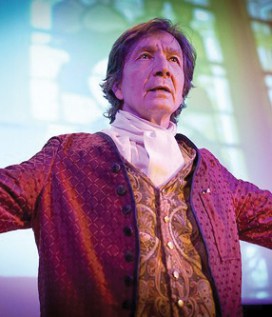This month’s round-up of short reviews includes a play about Newton and books about Internet spam and quantum randomness, reviewed by Margaret Harris

Let Newton be!
Isaac Newton was not a fan of the theatrical arts. On the one occasion when he is known to have attended an opera, he ran away during the third act. So it seems fair to surmise that the father of gravitational theory would have absolutely hated Craig Baxter’s play about his life, Let Newton Be! That, however, is no reason for the rest of us to avoid this excellent work. First performed in 2009 at Newton’s own Trinity College, Cambridge, the play toured a handful of institutions in the UK and US in 2011; however, as a physicsworld.com reviewer argued at the time (“Newton’s three body problem”, 30 March 2011), it deserved a much wider audience. Fortunately, someone in the publishing world agreed, and the play is now available in book form as The Isaac Newton Guidebook. In addition to the text of Let Newton Be!, the guidebook also contains a series of scholarly essays on various aspects of Newton’s life, introductions by both Baxter and Stephen Hawking and – best of all – a DVD of a performance by the splendid Menagerie Theatre Company. Probably the most useful of the essays is the one on Newton’s feud with Leibniz. The nature of this dispute was so complex, wide-ranging and important that Newton novices should probably read the essay about it before watching the play. Other than that, though, this is not a work that requires much introduction. Just sit back and enjoy the spectacle as the three different actors who play Newton take you through his life, his works, and his famously difficult personality.
- 2012 Faraday Publishing £25.00/$40.00hb 176pp
Getting spammed
“Mail is easily deleted and so ‘junk’ mail is not really a serious problem.” As an example of faulty prognostication, this statement – made in 1978 on a mailing list of ARPANET, the progenitor of today’s Internet – surely ranks right up there with Lord Kelvin’s supposed declaration that, by 1900, nothing new remained to be discovered in physics. The story of how junk e-mail, or “spam”, evolved from a minor nuisance into a serious problem is thoughtfully and engrossingly told in Spam: a Shadow History of the Internet. Written by Finn Brunton, a historian of technology at the University of Michigan, US, the book is initially rather hardgoing, with clunky phrases such as “foundational ambiguities”, “root paradigm” and “co-constitutive feedback loop” marring the introduction. However, once this little display of academic impenetrability is finished, Brunton the storyteller takes over. The rest of the book is pacey and packed full of interesting titbits, from the tale of the first commercial spam message (an advert for DEC computers that appeared on ARPANET on 1 May 1978), to an inside look at the professional spammers who plagued the loosely organized Usenet in the mid-1990s, and finally a sobering assessment of new forms of spam that seek to game search-engine algorithms. Like all good historians, Brunton is an interpreter as well as a narrator, skilled at placing facts in context. That ARPANET post about junk mail, for example, made sense at the time because its audience was a community of computer scientists, engineers, physicists and other defence experts who were used to collaborating and often knew each other personally. As Brunton puts it, the proto-Internet “was not the electronic frontier but a fairly small town, populated almost exclusively with very smart townspeople”. Once that population expanded, old strategies for keeping noxious behaviour under control – including ad hoc flame wars and revoking offenders’ access privileges – ceased to function. New ones had to be developed to replace them, and as Brunton explains, this is still very much a work in progress.
- 2013 MIT Press £19.95/$27.95hb 304pp
Alea iacta est
What does it mean for an event to be truly random? For science writer Brian Clegg, the answer depends on whether you are talking about classical randomness or chaotic randomness. As he explains near the beginning of his book Dice World: Science and Life in a Random Universe, classical randomness applies to things like roulette wheels and gambling dice: the outcome of a dice throw is uncertain, but it can be predicted using the standard tools of probability theory. Chaotic randomness, on the other hand, is the stuff of earthquake clusters, flapping butterfly wings and – in Clegg’s view, at least – the mysterious alchemy that transforms a handful of books into bestsellers. These things, he explains, are not actually random at all in the classical sense, because they cannot be controlled and are not easily predicted. Once this distinction is established, the rest of the book takes the reader on a tour of various forms of randomness and the methods scientists and mathematicians have developed to describe them. In addition to relatively well-known pioneers such as Blaise Pascal and various members of the talented Bernoulli family, Clegg also highlights the work of some lesser-known contributors to the field, including the Italian scholar and gambler Girolamo Cardano (see May 2009 pp36–40) and John Graunt, a button-seller with a sideline in statistics who became a member of the Royal Society. A light, quick read overall, the book does get into some weighty material later on, when quantum randomness and Bayesian statistics enter the picture.
- 2013 Icon Books £12.99pb 288pp


